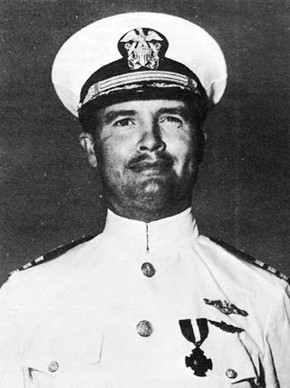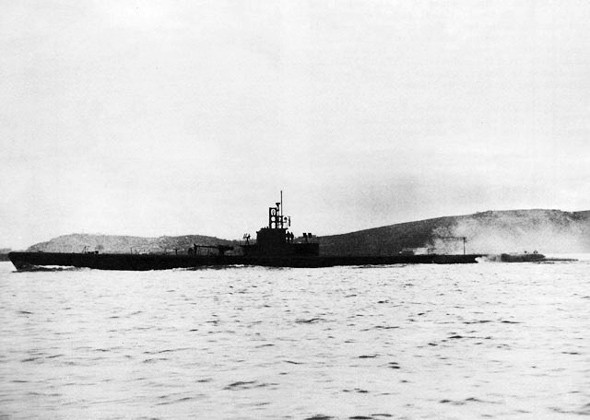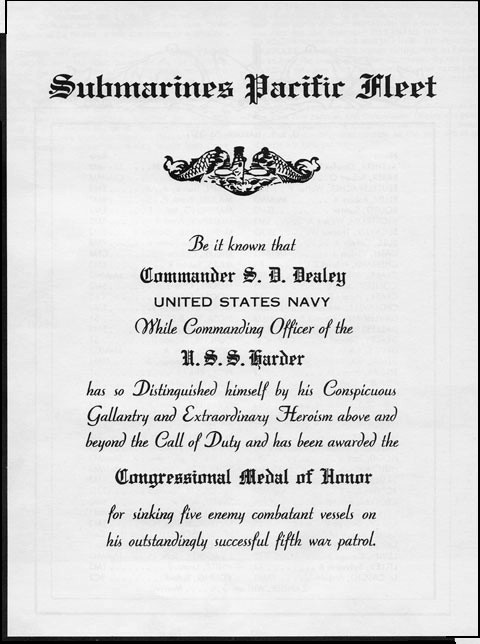
The Navy Department Library
Harder (SS 257)
Commander S.D. Dealey guided his eminently successful fighting ship, Harder,out of the harbor at Fremantle, Australia on 5 August 1944 to begin the sixth war patrol of that vessel. In company with Hake, Harder conducted training exercises enroute to Darwin. These two submarines topped off with fuel at Darwin, and on 13 August, together with Haddo, left for their assigned area west of Luzon, Philippine Islands. They were to patrol as a coordinated attack or wolfpack group, with Cdr. Dealey in charge.
On the afternoon of 20 August 1944, Ray, patrolling the same area, tracked a large convoy into Paluan Bay on the northwestern coast of Mindoro. An hour after surfacing, she contacted Harder just outside the bay and held a megaphone conversation with Sam Dealey. Dealey formulated a plan for a concentrated dawn wolf-pack attack on the convoy. Harder came alongsideHaddo at 0130 on the morning of 21 August and told Lt. Cdr. C. W. Nimitz, Jr., that at least 16 enemy ships were holed up in the bay. When the convoy made its exit at dawn (as convoys were wont to do) Ray was to approach from the northwest, Haddo from the west, and Harder from the southwest. Guitarro also had been drafted by Dealey, and was to attack from the northwest near Cape Calavite Lighthouse.
During the attacks which ensued, four ships, totaling 22,000 tons, were sunk, by Japanese admission. It is thought likely that Harder sank one of them.
On the following day, Haddo and Harder conducted a combined attack on three small vessels off Bataan. All three were sunk; these were the coast defense vessels Marsuwa, Sado and Hiburi. Haddo and Harder each received credit for sinking one vessel, and shared credit for the third sinking.
The morning of 23 August Haddo contacted a tanker escorted by a destroyer, and blew the bow off the destroyer in a down-the-throat shot. She fired her last torpedo in this attack, and in response to urgent calls for assistance, Hake and Harder rendezvoused with her.Haddo, being out of torpedoes, "received Sam's blessing" and left his wolfpack, heading south. Hake and Harder discussed plans for finishing off the damaged destroyer and then departed for their common objective off Caiman Point.
At 0453 on the morning of 24 August Hake dove not far from Caiman Point and about four miles off Hermana Major Island, west coast of Luzon, with Harder in sight 4500 yards south of her. Hake heard echo ranging to the south and soon sighted two ships. At first they appeared to be a three-stack light cruiser and a destroyer, but upon later inspection were identified as a three-stack Thai destroyer (the Phra Ruang, of 1,035 tons) and a minesweeper of less than 1,000 tons. Hake broke off the attack and headed north when the target zigged away apparently to enter Dasol Bay, while the minesweeper stayed outside.
At 0647 upon coming to a northerly course, Harder's periscope was seen dead ahead at about 600-700 yards.
Sound also reported faint screws on this bearing, so Hake turned away toward the south. At this point the minesweeper gave three strong pings, whereupon Hake saw her 2,000 yards away swinging toward the two submarines. Hake figured he had sound contact and went deep. The enemy kept pinging, but seemed to have the two targets located and to be undecided what to do about it. At 0728, Hake heard 15 rapid depth charges, none close. Two sets of screws were heard and each continued pinging on either quarter ofHake as she evaded to the westward. By 0955 all was quiet.
Harder never was heard from again. Her periscope was last sighted at 15°-43'N, 119°-43'E. Japanese records reveal that an antisubmarine attack was made on the same day at 15°-50'N, 119°-43'E with 440 pound depth charges. The enemy said, "much oil, wood chips and cork floated in the neighborhood." Presumably Harder perished in this depth charge attack.
Harder was officially credited with having sunk 20.5 enemy ships (the half credit was given for a ship sunk cooperatively with Haddo). This gave Harder a total of 82,500 tons sunk and she damaged seven ships for 29,000 tons.
Her first patrol was conducted in Empire waters, starting in June 1943. She sank three freighters, and
--105--
damaged seriously a freighter-transport, another freighter, a transport and a tanker. She went to the Empire again for her second patrol, and sank three freighters and a tanker, while she damaged a trawler.
Harder was part of a wolfpack, of which Pargo and Snook were the other members, on her third patrol. In the open sea north of the Marianas, she sank a freighter, three freighter-transports and an armed trawler. Harder's fourth patrol was in the Carolines. On 13 April 1944 she sank the Japanese destroyer Ikazuchi. She also sank a freighter and damaged a second destroyer. Harder departed for her fifth patrol in the Celebes Sea on 26 May 1944. She picked up coast watchers from northeastern Borneo, and gave a very valuable contact report on a major task force leaving Tawi Tawi anchorage, Sulu Archipelago, preparing to engage in the first Battle of the Philippine Sea. She sank the destroyer Minazuki on 6 June 1944. On the next day the destroyer Hayanami fell victim toHarder's torpedoes, and sank tail first. The destroyer Tanikaze was Harder's next victim, sunk on 9 June. On 10 June she damaged another destroyer. By the time Harder returned from this patrol, she had earned the reputation of being the Submarine Force's most terrible opponent of destroyers.
Harder received the Presidential Unit Citation for her first five patrols, and Commander Dealey was posthumously awarded the Congressional Medal of Honor for his outstanding contribution to the war effort on Harder's fifth patrol.
--106--

| U.S.S. Harder (SS-257) | ||||
|---|---|---|---|---|
| Name | Rate | Name | Rate | |
| Altherr, Charles R. Baber, Robert O. Beutelspacher, Walter F. Blum, Robert A. Bourg, Sumter Brostrom, Wayne A. Buckner, Thomas W. Bull, Calvin A. Cash, Vivian J. Chenard, Roland R. Clark, Wilbur L. Conley, John C. Crask, Howard F. Cromwell, James E. Dahlheimer, Donald B. Dallessandro, Vincent L. Dealey, Samuel D. DeVoe, Edwin W. Diamond, William V. Edgar, James M. Finney, Carl E. Fisher, George R., Jr. Gifford, Robert L. Glueckert, Joseph L. Gully, Daniel J. Haloupek, Walter O. Hatfield, Hiram D. Hood, Earl V. Hutcherson, Vard W. James, Daniel R. Jones, Roy E. Keckler, Roland W. Kellogg, James H. Lakey, George B. Lane, Joseph M. Lawson, Henry W. Levin, George B. Lilley, Sylvester B. Lo Cascio, Angelo Logan, Samuel M. |
MoMM2 MoMM2 SC3 MoMM3 GM3 SM1 LTJG RM2 MoMM1 F1 RT2 MoMM1 S1 StM2 MoMM2 TM1 CDR-CO F1 RM1 FC2 MACH MoMM3 TM3 MoMM2 Y1 ENS RAD.ELECTR. TM1 CMoMM LTJG MoMM3 CEM EM2 RT2 EM3 MoMM3 RT2 S1 PhM1 LT-XO |
Lonas, John P. Lynn, Harvey A., Jr. Majuri, Frank P. Manning, Ralph E. McGrevy, Frank B. McWilliams, Gordon K. Medley, Benjamin R. Miller, Chester Mills, Robert R. Moffett, Charles A., Jr. Moore, Otto J. Moore, Robert Morgan, Arthur B. Moss, Roy B. Murray, Myles H. Ogilvie, Thomas D. Opisso, Larry A. Paquet, Freeman, Jr. Peck, Elroy R. Pick, Richard S. Pratt, Ralph e. Przybilla, Robert P. Rogers, Marvin M. Rogers, Max M. Roosevelt, Robert B. Sampson, Philip T. Scheibelhut, Francis X. Schwartz, Melvin Simon, Donald J. Sloggett, Vernard L. Smith, Austin Snipes, John W., Jr. Snyder, Walker N. Sommerschield, Lloyd H. Spice, Nelson Swagerty, John T. White, Leonard Young, Buford Zander, William G. |
CMoMM TM3 EM1 EM2 EM2 Bkr3 RM2 CTM EM3 MoMM2 SM2 Ck2 EM2 S1 TM2 S1 MoMM2 GM1 S1 S1 S1 EM2 S1 TM3 ENS ENS MoMM2 MoMM3 RM3 LTJG TM2 MoMM1 TM3 Cox MoMM3 MoMM3 TM3 SC2 MoMM2 |
|
--107--
--108--






